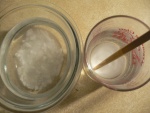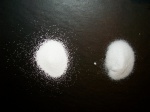Difference between revisions of "Washing Spice"
(→Alkaline Solution Washing of Inactive Impurities) |
|||
| Line 7: | Line 7: | ||
===== Alkaline Solution Washing of Inactive Impurities ===== | ===== Alkaline Solution Washing of Inactive Impurities ===== | ||
| − | Most of the impurities that plague yields tend to be quite soluble in both alkaline aqueous solutions and non-polar solvents. To remove these impurities, an imbalance in equilibrium must be created between these two types of solutions, causing the impurities to disperse into a disposable solution from the solution containing the product. This procedure is commonly used for purifying product from extractions that utilize naphtha or heptane to obtain a whiter product | + | Most of the impurities that plague yields tend to be quite soluble in both alkaline aqueous solutions and non-polar solvents. To remove these impurities, an imbalance in equilibrium must be created between these two types of solutions, causing the impurities to disperse into a disposable solution from the solution containing the product. This procedure is commonly used for purifying product from extractions that utilize naphtha or heptane to obtain a whiter product. |
| − | {{Procedure|Washing Spice | + | {{Procedure|Washing Spice of Inactive Impurities Using Alkaline Solution<ref>[[Acolon 5's Spice Washing Tek]]</ref>| |
# Saturate a solution of warm water with a weak base such as sodium bicarbonate (baking soda) or sodium carbonate (washing soda) to render an alkaline solution. | # Saturate a solution of warm water with a weak base such as sodium bicarbonate (baking soda) or sodium carbonate (washing soda) to render an alkaline solution. | ||
#* ''sodium bicarbonate can be [[#Conversion of Sodium Bicarbonate into Sodium Carbonate|converted to sodium carbonate]].'' | #* ''sodium bicarbonate can be [[#Conversion of Sodium Bicarbonate into Sodium Carbonate|converted to sodium carbonate]].'' | ||
Revision as of 05:29, 27 January 2010
| Note: | This page has been transcluded to The Nexian DMT Handbook under the Washing Spice section or other locations within or without the handbook. Please markup in consideration of this. The top section header is to remain in place as a reference for subsequent section headers and to allow easy editing directly from the handbook. |
Contents
Washing Spice
The purpose of washing is to disperse impurities off of the product or out of a solution containing the product and into an intermediate solvent.
Alkaline Solution Washing of Inactive Impurities
Most of the impurities that plague yields tend to be quite soluble in both alkaline aqueous solutions and non-polar solvents. To remove these impurities, an imbalance in equilibrium must be created between these two types of solutions, causing the impurities to disperse into a disposable solution from the solution containing the product. This procedure is commonly used for purifying product from extractions that utilize naphtha or heptane to obtain a whiter product.
| Washing Spice of Inactive Impurities Using Alkaline Solution[1] | |
|---|---|
|
Solvent Washing and Isolation of Active Impurities
Removal of active impurities generally relies strictly on differences of their solubility or insolubility in specific solvents. Most notably, Jungle Spice may be removed from DMT using particular solvents such as naphtha or heptane.
Appendices
| Conversion of Sodium Bicarbonate into Sodium Carbonate | ||||
|---|---|---|---|---|
|

